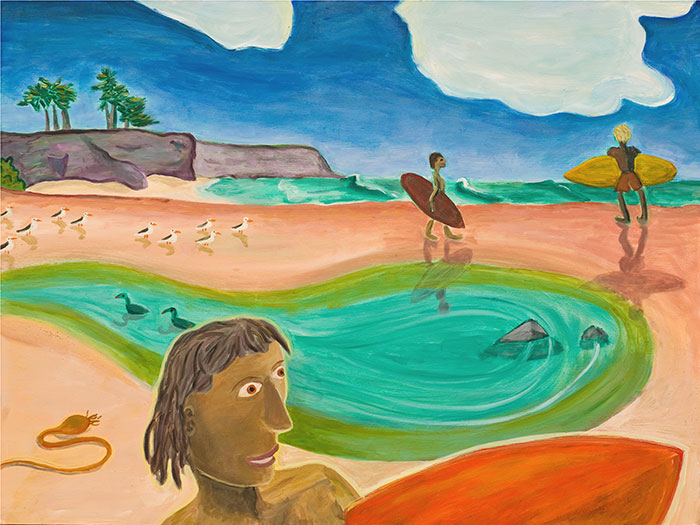
Val and Me
by Rudy Rucker
.
I’m Jim Oster. I grew up in Sunnyvale, a knot of freeways near San Jose, California. My father was an electrical engineer, and my mother sold online ads. Dad was what you might call piebald, with different colors in his hair. He stared off into the distance a lot, always thinking about his projects. Mom had warm eyes, and she’d smile and nod when she happened to look my way. But she spent most of her time staring down at her little phone’s screen.
During my senior year in high-school, I used to play hooky and go surfing in Santa Cruz—it was only a half hour’s drive away. In the morning, I’d stuff my wetsuit into my backpack—instead of carrying books.
My parents didn’t notice, and if they had they wouldn’t have cared. They’d had their one child, me, and by now they’d turned to other concerns: their jobs and their investments. My grades weren’t a big issue senior year, as I’d already been accepted for admission at the University of California.
In high-school, my favorite surf break was off a rocky point at Four Mile Beach, on Route 1 north of Cruz. My friend Chang would drive us over there. Chang wasn’t into studying at all, he was planning to be a pro surfer, and he figured his day job could be dealing pot. He had a vintage blue Haut board with an epic feel. I was more of a short-boarder, working snappy moves up and down the tubes—when I wasn’t wiped out and floundering in the foam.
Some the locals at Four Mile had taken to hassling us. A spaced-out raw-boned guy called Skeeves was on my case in particular. He was a little older than the rest of us. All he did was surf, and he lived in his van.
One particular afternoon, I did a drop-in on one of Skeeves’s waves, forcing him away from the curl. When we got back to shore, he put his face really close to mine and started yelling curses at me, even throwing in some gibberish-type incantations that he’d learned. Skeeves had this idea that he was hooked into the magic of the pyramids—or some shit like that.
“Shit-beetle!” yelled Skeeves. “Ankh salaam Amenhotep.”
“Calm down,” I told him. “It’s just a wave.”
“ Ruh nuh port mu hurra,” Skeeves intoned, making weird gestures with his hands.
“Dude’s having a fit,” said Chang, standing at a safe distance. “His brain is slushed.”
“It’s a magic spell, fool,” said Skeeves. “The chant is called ‘leaving in the daytime.’ I might send you two out of your bodies.” He crouched and picked up a dense, sharp rock.
“Let’s go, Chang,” I said, briskly heading down the beach, leaving my board behind. “We’ll get some beer,” I called back to Skeeves. “You can have all my waves while I’m gone.”
Skeeves’s van was parked in the lot near Chang’s pickup. Skeeves lived in this van, mostly, and he had tinted glass in the rear windows. He’d painted occult symbols all over the vehicle—ankh crosses with loops on top, scarab beetles, hovering eyes, hieroglyphs, and a long pair of wings flowing back from the front wheel wheels. Peering in through the van’s dusky rear window, we could make out a big gold casket in the back of the van.
“Skeeves got into the Egyptian stuff when he started dealing dope to Julian Crocker in San Francisco,” said Chang. “I think he just got that gold box.”
“Who’s Crocker?”
“He’s a screwball descendant of this rich old family. He lives in a mansion with all these wack antiquities. Skeeves is up there all the time. Last week he was putting together a deal to sell Crocker a bunch of ketamine.”
I brooded about Skeeves on the short drive to the Quick Mart in Davenport and back. And when we got back to the Four Mile Beach parking lot, I took a knife out Chang’s glove compartment and slashed one of the front tires on Skeeves’s van.
Chang and I carried the beer down to the beach and had a mellow hour or two on the waves. I even forgot about slashing Skeeves’s tire—until we all went back up to the lot together.
Skeeves got all excited. Chang was laughing so hard that the weird old surfer quickly figured out it was me who’d done the deed. Skeeves said he was going to kill me—he fetched an axe with a green-painted handle from the van. I was scared. It was hard to tell what Skeeves might do. And it looked as if the axe blade already had blood on it.
Chang and I drove away and we didn’t come back to Four Mile for awhile.
It was maybe the next day when we saw in the paper that Julian Crocker had been found dead in his home. The cops thought it might be a drug overdose. Crocker was found lying beside a fireplace filled with ashes. Apparently he’d suffocated from some smoke. And an ancient gold sarcophagus was said to be missing from the Crocker manse. But there were no actual signs of robbery. In any case, Crocker’s surviving relatives weren’t interested in trying to make a case. And the cops quickly lost interest.
Quite a few of the surf crowd must have suspected that Skeeves was involved—especially with that funky gold casket in his van. A rumor was circulating among us that Skeeves was now fucking a mummy that he’d found in the gold box. Not that any of us was going public with this stuff.
Chang and I had switched to surfing Pleasure Point down near 41st Street in Cruz. There were some psychos there, too, and a few of them make a point of picking on us—especially when they found out that we were valley guys from near San Jose. Chang toughed it out and got in with the brahs—his steady supply of weed was a help. But I couldn’t get past the hostility.
And then I was, like, fuck it—and I went back to skateboarding. I’d never been that good of a surfer anyway.
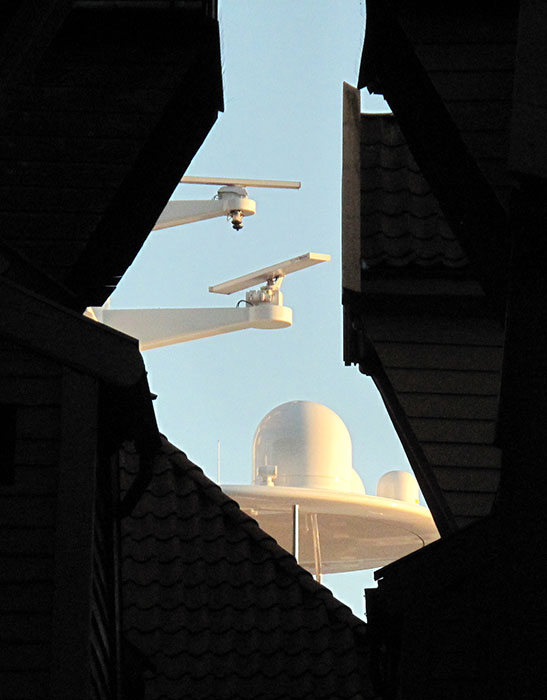
After high school I went to college at the Santa Cruz campus of the University of California. I decided to go for a bachelor’s degree in bioengineering. Everyone said biotech was the coming thing, and the courses appealed to me. I’d always liked videogames, and I dug the idea of viewing the natural world as being a big program that we could mod and hack.
Of course there were people—especially around Cruz—who worried that biotech was going to bring on some filthy germs who’d kill us all. My professors said that wasn’t a real problem because, if you looked into it a little, you could see that our whole entire ecology is made of plants, animals, and microorganisms who want to eat everything. All the species had been mutating and evolving for billions of years, each and every one of them striving for world domination. And no piddly-ass organism we were going to cook up in a lab had any chance of taking down the ancient, battle-scarred pros. To hear my profs tell it, home-brewed germs were like high-school grommets facing the gnarly surfers of Four Mile Beach.
Well, maybe they were right, and maybe not. Either way, I figured it would be good to have a rebellious, clear-minded guy like me on the inside of the biotech biz. I’d be ready to blow the whistle on the Earth-rapers, if it ever came down to that. Meanwhile I was hoping to discover some cool things, and to make a good living as well.
My old friend Chang was living down in Cruz by now, too, surfing his ass off. He won a few local contests, and during my junior year at UC Santa Cruz, he got invited to the annual Mavericks big wave contest a few miles up the coast. I went to watch him, that is, to watch the faint line on the horizon where the big waves were. On the TV monitors, we could see Chang carving sick curves into the wobbly mountains of glass. He placed in the top five and he picked up some sponsorship deals.
Chang came by my rented room a month after Mavericks and lent me a board so we could go riding at Four Mile like old times. Sure enough, our man Skeeves was still on the waves, indefatigable as a Terminator robot, still living in his Egyptian-themed van.
By now Chang was in some sense a friend of Skeeves, that is to say, Skeeves’s over-tweaked synapses could successfully achieve a pattern-recognition of Chang’s face. He walked over to us and Chang broke out a joint. Skeeves seemed to recognize me, but, so far as I could tell, he’d forgotten about the slashed tire.
I figured the joint was like a peace pipe. But after a few tokes Chang, never one to let things stay calm, started ribbing the eccentric old surfer. “Getting much?” Chang asked him. “Still fucking the mummy?”
Even when Skeeves had his shades off, you couldn’t really see his eyes, buried as they were in the creases of his weathered lids. He turned his head towards Chang, moving as slowly as a plant tracking the sun.
“Just the girl,” allowed Skeeves in a low murmur, his tongue loosened by the pot. “Not the guy who’s in the box with her. Julian Crocker and I smoked the third mummy, you know. Amenhotep. He was down under the other two, all crumbly like rotten wood. We burned Amenhotep in Crocker’s marble fireplace, the two of us leaning into the fumes, very resinous, very tasty. What a rush. But then Crocker died, the fuckin’ light-weight.”
“Mummies?” I said numbly, feeling the layers of reality come peeling off.
“That mummy girl—she’s softer than you’d think,” came Skeeves’s raspy whisper. “Good stuff. It’s more like she’s in a coma. Every now and then, in my head, she talks to me.”
“Can we see them?” asked Chang. “They’re in that gold sarcophagus in the back of my van, right? You’re legendary, dude.”
“I—I don’t think Jim here could handle it,” said Skeeves thoughtfully. “The spirit of Amenhotep destroys the weak.”
“Did you say that you smoked Amenhotep’s mummy?” I had to ask. “You and Crocker?”
Skeeves squinted at me for a long time.
“Remember the axe, Jim,” he said, finally, and laid his bony finger over his lips.
I knew then that Skeeves hadn’t forgotten about the slashed tire at all.
But, now that he’d shared his secret with me—or run me through a bizarre put-on—we were closer than before. From then on, when I crossed Skeeves’s path around Cruz, I’d wave, and he’d favor me with a slow nod. Not that I spent that much time thinking about him or about the gunjy coma-chick who was supposed to be in his Egyptian sarcophagus.
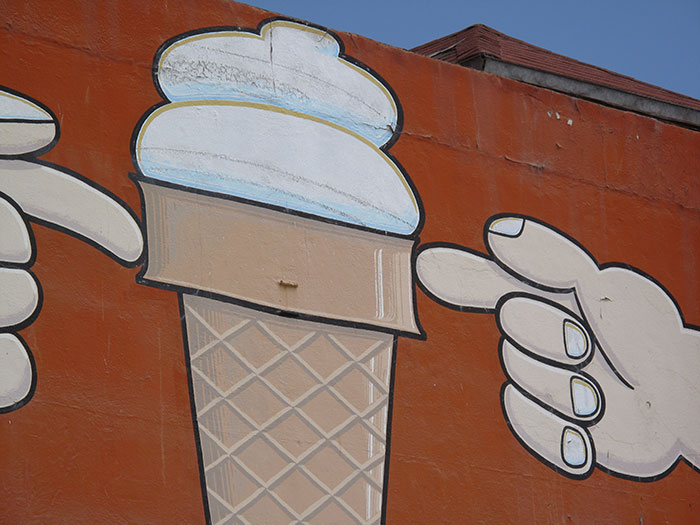
Though I didn’t really like to admit it, I was in fact studying pretty hard at school. I sometimes dreamed of finding a new way to think about bioengineering. I imagined discovering some easy way to visualize how the low-level DNA base-pairs lead to the high-level morphogenesis that shapes animal embryos and plant sprouts. And then we’d no longer be groping in the dark, twiddling switches with no sense of what controlled what.
I didn’t have much of a social life, or many relationships with women. I wasn’t attracted to the grade-grubbing engineer women I worked with. And the alluring liberal-arts types always wanted to have that discussion about whether biotech was evil. When I wanted a break, I’d ride my skateboard downtown and thrash at the punk clubs.
Both my parents died the winter before I graduated. That was a really rough time. Dad had a stroke, and Mom, usually so quick and warm, sank into a depression that segued into brain cancer. It was hard to believe. I hadn’t been all that close with my parents, but all those years I’d known they were there, in some sense standing between me and the Reaper. And now they were gone.
Only a few people showed up at my parents’ funerals. Fellow workers: engineers and sales reps. No relatives. It sucked. My parents had never really connected with the larger world, they’d been eaten by their jobs. I promised myself I’d find a warm, loving woman and that we’d build a jolly close-knit family.
As it turned out, my parents didn’t leave me any kind of inheritance at all. They’d fallen for some Houston company’s wealth-management scam that involved getting a second mortgage and putting all of their cash into leveraged insurance-market securities which had totally tanked. I’d always thought Mom and Dad were smarter than that. The bank foreclosed on our house, and even the cars got sold.
Fortunately I had a student loan to cover my costs. I plugged along at school. In a way, that was easier than having a breakdown and dropping out. And, as a practical matter, I needed to finish up my senior project and get a job.
In the spring I got my Bachelor’s degree in bioengineering and I started hitting the interviews. I didn’t really want to stay in academia, even if I could have afforded it. My impression was that the real biotech action wasn’t at the universities—the big scores were at the industrial labs. Why be sitting out the action and getting a Master’s degree or a doctorate?
I landed what seemed like a good job at a biotech startup called Wiggler Labs, right there in Santa Cruz.
Wiggler was about bioenergy. Some other companies had been designing new versions of our shit-eating friend, the Escherichia coli bacterium that populates our guts. The new, tweaked E. coli strains were brewing long-chain forms of alcohol that were just about as good as gasoline. But our bioenergy rivals still had to distill the alcohol from the germ slime, and burn the alcohol to get the energy—creating fresh pollution along the way.
My new employer’s plan was to go straight from shit to electricity. That is, Wiggler Labs was designing germs that would eat whatever gross, random crud you fed them and they’d pump out power in return. The trick was to enhance our bacteria with some genes from a particular kind of electric eel, the Electrophorus electricus—a forty-pound, gray, slimy dude native to the stagnant backwaters of the Amazon River Basin. These eels can put out seven hundred volts a pop.
Wiggler had a giant tank with about a half dozen of the big electric eels in the lab’s reception area, along with the shrimps and frogs that the eels liked to shock and eat. Not that we really needed to keep that many electric eels around, but the display impressed the investors who were coming by all the time. It was a professional-quality tank, with a muddy river bank along one side, and a mangrove tree with orchids and ferns.
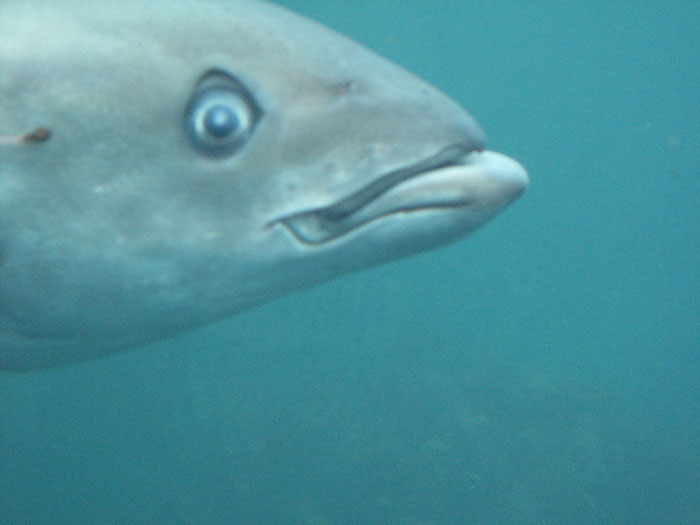
We had pans full of eel-flesh tissue-cultures on the lab’s work benches. Things were moving right along. We learned how to tweak the eel DNA, and how to splice eel genes into E. coli to make electric germs. And before long we had a couple of electric germ culture vats running—smelly tubs with tiny blue sparks crackling along their swampy surfaces. Brass collector knobs along the vats’ edges drained off the energy and stored it in batteries.
But Wiggler wasn’t anywhere near a commercial level of throughput. In those early months, if you’d you wanted to power your TV with a Wiggler vat, your bill might have run to fifty thousand dollars a month—what with all the tech support.
Week after week we tinkered with getting the genes right. We had to baby the eel-tissue cultures, and the electric germs were especially fragile. Our creations kept falling prey to wild molds and viruses that drifted in, looking for unsophisticated victims to trash. I was beginning to understand why the profs had been so skeptical about a biotech plague. Nature is a bitch—heartless, wily, and street wise.
But never mind the difficulties—Wiggler Labs had achieved a proof of concept. The venture capital came pouring in, and management was talking about having an IPO stock offering in about a year.
I was working insane hours and learning all kinds of stuff. But after nine months at the job, I started getting bored. As a low-level employee, I spent most of my time tending the eel-tissue cultures, or mapping genes with our scanning-tunneling microscope, or just mopping slop off the floors. Sometimes I felt like I worked at a slaughterhouse or at a sewage plant.
After the tenth or fifteenth that our electric germs all died off, I began seriously doubting if our power vats would ever reach the market. I was getting a sense that the managers’ plan was to pump up the stock price, and to dump their shares after the IPO. Sometimes I’d speculate about this with the other engineers, which created bad blood when the managers overheard me.
By way of running my mouth, I also enjoyed getting my co-workers to discuss the ethics of bioscience. To get a good argument going, I liked to play Devil’s advocate, and to advocate various extreme scenarios. One day, in an antic mood, I started telling the guys in the lunch room that we should let the state of Texas secede. My concept was that, with Texas a foreign country, we’d be free to bomb the whole state with electric germs. And then we’d set up power collection plants around the state’s barbed-wire borders and have endless free power flowing out!
I hadn’t registered the fact that Wiggler’s chief financial officer happened to be sitting at the table right behind me. He was—a Texan.
He led me into his office, showed me a photo of his family, and talked about collegiality, team spirit and public image. And the next day Human Resources gave me my thirty days notice.
This left me just enough time to attend the company picnic.
Like a complete pinhead, I stole a couple of pans of mutant eel-flesh from the lab, doused them in tamari sauce, scattered on sesame seeds, and roasted them in the kitchen of the little cottage I’d rented in Santa Cruz. I sliced up the roasted electric eel meat, and laid it out on a big black lacquer tray like a fancy appetizer—to bring to the picnic. Chang happened to be at my house, delivering some pot, so I brought him to the company picnic too.
People were actually eating the gene-tweaked eel flesh, going, like, “Hmm, this is tasty.” By the time the meat was about half gone I was drunk and stoned enough to announce what it was.
“We eat what we grow!” I whooped, and let out what I considered to be a Texas-style yodel.
Some of the engineers thought I was funny—but the execs and the staff were majorly pissed. Not that eating the tweaked eel would actually be bad for you. Your stomach acids break down all the DNA you eat—it doesn’t go and crawl into your cell nuclei. But, still...
Nobody went public with the story of my misdeed, but word got around. From then on, I was pretty much blackballed from the biotech biz. I’d phone up for an interview, and I’d hear the receptionist fighting back a laugh.
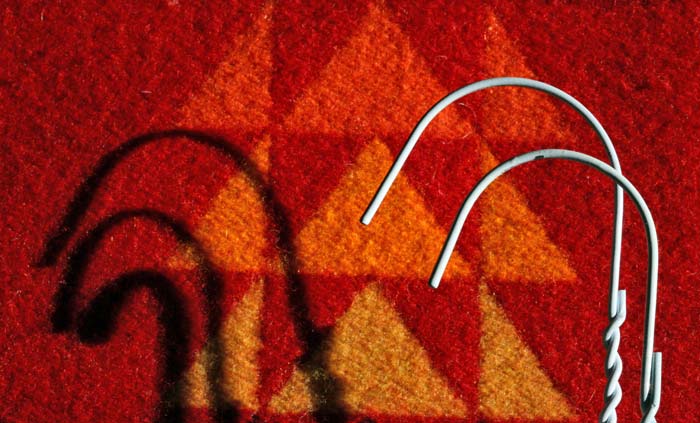
I got a pretty good severance package from Wiggler. For awhile I had some hopes of striking out on my own—I still had my vague notion of finding a better mental model language for the process of genetic engineering. And if my theorizing didn’t lead anywhere, maybe I could get into designing lab equipment. One of the few things I’d inherited from my Dad was a workshop’s worth of tools.
The house I’d rented in Cruz was a granny cottage in the back yard of a biggish stucco home on Madrone Street. My house faced the alley. My landlords were a Dick and a Diane Simly. Dick owned a high-end car dealership called Simly The Best. The lot was switching over to hybrids and electrics, so Dick and Diane drove a pair of gas-guzzler Jaguars that Dick hadn’t been able to sell. Somehow Dick had made a profit by keeping these two cars—the guy always came out ahead.
Generally speaking, Dick and Diane left me alone. And when I adopted a puppy from the pound to keep my company, they didn’t squawk. My dog’s name was Droog—he was a collie-beagle mix. He liked to follow me around the house, watching everything I did. It was almost like I had an assistant.
Working on the screened-in side porch of my cottage, I built a scanning-tunneling microscope of my own—you call it an STM for short. I found the design on the web, and the parts only cost me about a thousand dollars. Why did I build an STM? Well, I still had some dreams of making a genomics breakthrough on my own—or of managing to patent a new wrinkle on the lab hardware.
Basically an STM works by bringing a tiny sharp tip close to a sample that’s resting on a little sample sled. You run voltage into the tip and the sample, and you track the virtual current that seems to flow across the gap. A computer munges the data and turns it into a display that resembles a bumpy surface—with the bumps being individual atoms. Even better, you can use your scanning tip to manipulate the individual atoms.
Obviously it’s important to have a very narrow scanning tip in your STM. For my home-built machine, I was using slivers of tungsten needles whose tips were only one or two atoms thick, just like we’d been doing at Wiggler Labs. I began wondering if there might be a way to find some better kind of scanning tip. If I could come up with that, maybe I’d have a way of getting better STM images, and that could lead to something marketable.
One afternoon, gnarly, funky Skeeves happened to come walking down the alley by my house. He didn’t seem to be looking for me, I think he was just wandering around. I was feeling a bored and lonely, so I called out to him, gave him a beer, and showed him some of the pictures I’d been making with the STM.
“This is a hair,” I told Skeeves, flipping through the images on my computer. “This is a grain of pollen. And here’s an ant’s mandibles.”
“Ant,” said Skeeves, studying my computer screen. He reminded me of a dog trying to read. “Ants have hair? Can you see an atom?”
“Yeah, yeah. When I worked at the biotech lab, we were getting pictures of DNA. But those are pretty fuzzy.”
“Which part makes it sharp?” asked Skeeves, running his long, shaky fingers over my scanning-tunneling microscope’s boxes and wires.
“The scanning tip,” I said, pointing out how it slid back and forth above the samples. I went on to tell Skeeves about my quest for the sharpest needle ever. Not that he seemed to be listening to me. As if paralyzed by boredom, he lolled back in his chair, staring up at the corner of the ceiling as if someone else’s voice were coming from up there. Soon thereafter, he’d finished his beer and left.
A week later, Chang showed up at my house.
“I’ve got something for you,” he said, taking out a little match-box.
“Dope?”
“Sure,” said Chang. “But what’s in this box is a weird little prong of exotic matter that Ira stole from the lab. A tip for your whatchamacallit. Your microscope thing.”
“Ira?”
“You know him,” said Chang. “Little guy? Gnarly surf punk? Gay? Has a crush on Skeeves? He works nights as a janitor in the UC Santa Cruz labs.”
Chang handed me the box and I looked inside. The new tip was the shape of a toothpick, and at the sharp end, it cusped out into a point that was impossible to see.
“Ira gave you this for my STM?”
“Sold it to me,” said Chang. “For a bag of pot. Which you’ll have to pay for. Skeeves told Ira you needed a sharper tip. I guess he heard that from you?”
“Uh, yeah, I saw Skeeves not too long ago. But it didn’t seem like he even understood what I was saying.”
Chang laughed. “The way Skeeves works is that he remembers what he sees and hears and then it talks it over with the woman’s voice he hears in his head. He’s still living in his van with that casket with the mummies, you understand. And he talks to the spirit of the woman mummy that he fucks. He’s let me see the sarcophagus up close—though he won’t let me look inside. The box is all gold and covered with those wiggly Egyptian diagrams. Thousands of years old, according to our man.”
“Why isn’t Skeeves in jail? Or in the nut house?”
“He has this knack for falling between the cracks,” said Chang, shaking his head. “Beneath notice. Beyond belief.”
“And you’re saying that Skeeves told Ira to find me a better tip for my STM?”
“What it is, brah. Skeeves’s mummy woman’s soul hipped him to your trip.”
Again I had that feeling of reality being a laminate of layers—and that some of the layers were flaking off.
“Okay,” I said. “I’ll pay for Ira’s pot.”
I asked around a little, and found out that Ira’s tip was a stiff whisker of metallic hydrogen. One of the UC physics profs had had found a way to keep the stuff stable at room temperature. And Ira had stolen a random scrap that just happened to have the shape I needed.
The tip’s narrow end was, I initially thought, a single row of protons. But now, thinking back on where that tip led me, I’d say that it must have incorporated a unique quantum anomaly. I think it must have contained an infinitely thin cusp of warped space. Going a little further out on the edge, I’d go so far as to speculate that the soul of Skeeves’s mummy woman had done some special tweaks on that tip.
But, to start with, all I knew was that Ira’s scrap of metallic hydrogen was very sharp. And, so far as I could find out, the physics prof wasn’t thinking at all about scanning-tunneling microscope tips. So for a couple of weeks I was hoping I might have lucked into a new and patentable technological process.
But, to my disappointment, my metallic hydrogen tip didn’t work any better than the carbon nanotubes that the big labs were using. Although my new scans were cleaner than they’d been with the tungsten tip, they weren’t any sharper than the carbon nanotube pictures that I could find online. And in any case, it didn’t seem like a realistic business model to base a product on metallic hydrogen tips that a janitor friend of a friend was stealing from a lab.
So, okay, my STM was really just a hobby, a science toy. I wasn’t going to find any patentable new process here. And I wasn’t really going to be using my STM for any independent biotech research. Truth be told, I’d come to think of bioengineering as slow, boring and, yes, potentially evil.
By now my severance pay had run out and I needed a job. Lacking any better ideas, I got a job as mailman working out of the Santa Cruz post office. In a way, I’d always wanted to be a mailman. It’s a clear-cut social good. Nobody ever comes up and tells you that delivering mail is evil. And I liked going out to walk the streets every day. By now, my dog Droog was well-behaved enough that I could leave him home alone.
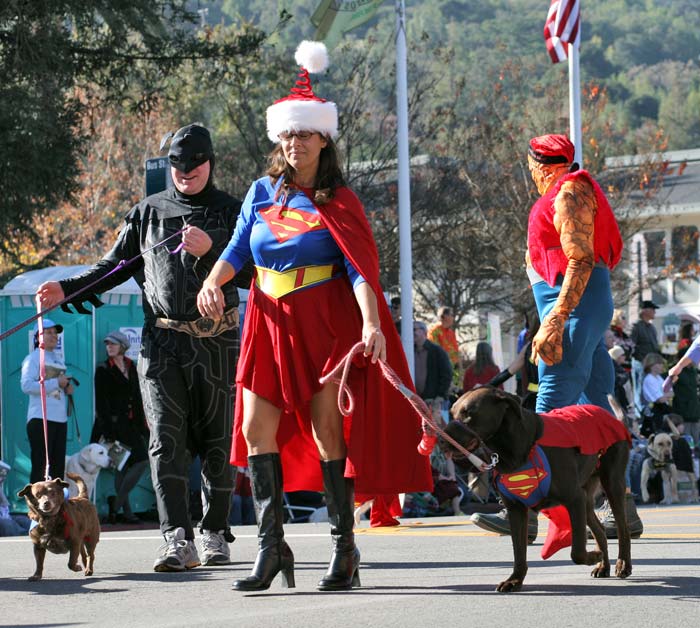
I started noticing a certain woman my age on my mail route. She shared a house with a couple of other people, and most afternoons she’d be out in front reading, or tending to her cactus plants.
“Nice shorts,” she said to me one day, commenting on my postal uniform. “And, hi, I’m Val.”
“I’m Jim. I like your cactuses.”
“Succulents. I’ve been collecting samples from other people’s yards. I break off a couple of leaves, or a sprout, and I stick them into the dirt. They like to grow.” Val smiled at me. She had nice eyes, green with flecks of brown. And shiny brown hair. “How did you end up being a mailman?”
“I got a degree in bioengineering at the UC,” I said, setting down my mail bag. “And I had a job in a lab, but it didn’t pan out. Not everyone got my sense of humor. Recently I was doing a little research on my own. But now I’m delivering mail.”
“You tweaked genes?” said Val. “Isn’t that bad?”
“It might be,” I said. “If we ever got good at it. At this point, it’s like we’re trying to program a computer by hitting it with a hammer. When I started, I thought I’d be helping people to decorate themselves with tentacles instead of tattoos. Or that I’d grow myself an extra dick.”
“There’s something wrong with your first one?” said Val pertly.
“Lately I haven’t checked,” I said, studying her. “I live alone with my dog.”
Val was vivacious and cute, with a playful curve to her lips.
“What?” she said as I continued gazing at her.
I gathered my courage. “Would you want to go out tomorrow night? We could get some food and see a punk show.”
“Not a regular punk show,” said Val. “Zonked sweaty boys elbowing me. Maybe the women’s roller derby? That’s punk, too, a little bit. I know some of the women who skate.”
“That’d be perfect,” I said. “Just so I’m with you.”
“Deliver the mail!” said Val, acknowledging the compliment.
“How come you’re always at home?” I asked, wanting to keep the conversation going. “Are you a grad student?”
“I’m a kindergarten teacher,” said Val, drawing herself up and giving me a stern stare.
“I’ll sit on my mat. I’ll eat my slice of apple.”
“That’s good, Jim.” She went back to being a pretty girl in her yard. “I have a short work-day. It’s nice.”
We started seeing each other a lot. Val didn’t seem like a teacher at all—she liked to dance, she joked about sex, and sometimes she’d smoke pot with me. Not that we partied all that much. I’d cleaned up somewhat after my Wiggler flame-out.
I loved talking with this woman. Even more than the things she said, I liked the music of her voice. Our conversations were like opera duets, where the rich, vibrant tones matter as much as the specific words. Val was naturally good-humored, always ready for fun. And my dog loved her.
Our romance took its course. Val moved in with me, and we got married.
Finally my life was on the right track. Val and I were, like, California-style salt of the earth: a kindergarten teacher who grew cactuses, and a mailman who dabbled in high-tech research. I liked how low-stress it was being a mailman.
Val and I spent a lot of time just hanging around our little pink cottage, being comfortable. Other times we’d go on road trips, camping near the sea, bringing Droog on the trips. We even started to talk about having a baby.
I was more and more removed from biotech. If I could enjoy life being happy with Val, that was enough. Even so, I was still playing with my scanning-tunneling microscope a little bit. It was cool to be able to see stuff all the way down at the atomic level.
“I have something to show you,” I told Val one night after supper. “My favorite molecule.”
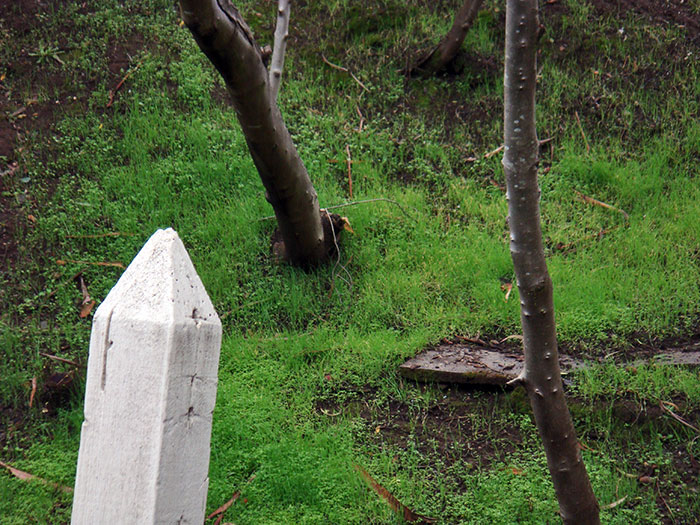
It was February, with a fairly powerful rainstorm outside. Droog was asleep on his cushion by the heating vent. I’d worn a slicker and boots to deliver the mail that day, and had gotten wet just the same. Dear Val had greeted me with a nice pot of lentil soup.
“Where does your molecule live?” asked Val, her face warm in the candle light. We liked having little romantic dinners, complete with candles and wine.
“The molecule’s a she,” I said. “I call her V. She’s on the porch.”
“Inside your junk pile?”
“That’s it. Come on.”
My STM was a small mound of random-looking tech equipment. I had a computer with a big-screen display, a binocular optical microscope for bringing the STM’s tip close to the sample sled, a set of piezoceramic widgets for moving the tip, and an ozone-smelling electrical transformer.
The rain was picking up, with water flowing down the window panes in wavy sheets. The dark palms were whipping back and forth, and thunder boomed across the sea.
“Lightning!” said Val, glancing out the window, her eyes soft and dark. “It’s like you’re the mad scientist in his laboratory.”
“Just where I’ve always wanted to be,” I said. “With a beautiful wife to care for me. I’m glad our roof doesn’t leak.”
“We wouldn’t want your pet molecule, V, to get wet.” She giggled and perched herself on the beat old armchair we kept out here.
I cranked up the scanning-tunneling microscope, and the transformer made just the kind of rising whine that you’d expect from a science-fiction lab. I checked the positioning of the sample, then threw the switch that engaged the piezoceramic manipulators. They made a nice clicking sound. I set them to sweeping Ira’s metallic hydrogen tip back and forth across the sample surface. An image began developing on my computer screen, an archipelago of dots.
“What is this molecule?” asked Val.
“It’s you! I took skin flakes from your hairbrush, extracted some DNA, and fixed one of the strands to a graphite plate. See how shapely you are?”
We could see a blurry double helix, coiled around like a kelp stalk on the beach.
“Oh, don’t tell me you want to tweak my genes!” protested Val. “Ugh.”
“Just admiring them for now,” I said. “We’ll use the old-school method for any tweaks.”
“Tonight might be a good time to try,” she said softly.
I went over to her and gave her a kiss. And then we were in bed, making love. It definitely added some spice to know we were doing it for real. Unprotected. Hoping to make a baby.
To top things off, just as we came, lightning struck a power pole across the street. The lights went out, and the scanning-tunneling microscope on the porch made a popping noise that was lost in the astonishing clap of thunder.
For a second or two, Val and I lay there stunned and half-deaf. Droog was whining in the kitchen. A siren sounded in the distance. In the velvety darkness, I seemed to see a glowing yellowish dot come zigzagging into our room.
Val cried out. The bright spot homed in on us and disappeared in the tangle of our bedding.
“Did something just now crawl inside me?” exclaimed Val, her voice rising. She sat up, throwing back the sheets. “I swear I felt a tingle down there—what’s going on, Jim! Help!”
I fumbled for the matches on the nightstand and got a candle going. My hands were shaking.
Beautiful naked Val was next to me, her eyes big and wet. Seeing her made everything seem safe.
“It’s okay,” I told her, putting my arms around her.
“But I saw something flying towards us,” insisted Val. “Like a bug.”
“A lightning bug,” I said, trying to joke. “It was just an afterimage. From the flash. Nothing crawled inside you. No way.” I gave her belly a gentle pat. “Nothing in there but you and me.”
Val peered down at herself and let out a shuddery sigh. She managed a little smile. “What a story for the baby. If this was the time.”
A fire truck rumbled into our street with its radio going. The rain was still pouring down. We could see a charred utility pole and some sparking wires. We put on our robes, got some cookies from the kitchen, and stood by the window watching, with Droog at our feet. The firemen put up barriers around the live wires and left.
Before returning to bed, I looked in on my scanning-tunneling microscope—it had blown a heavy spark, charring the sample on its little sled. The metallic hydrogen tip had shattered into a little stub. I turned off all the power switches and set the sample sled on a corner of my desk. The next day I figured out that the power surge had shorted out something in the STM—but I didn’t get around to fixing it. The sample sled stayed there on my desk where I’d put it.
Winter turned to spring. Green sorrel sprouted all over the back yard. And one day Val had some news for me when I came home from work. As soon as I walked in, I could see it on her happy face.
“You saw the doctor?” I asked.
“We’re expecting!” she sang. “It’s gonna happen. Oh, wow, Jim, do we have to start being grown-ups?”
“Never,” I said. “We’ll be the cool kind of parents.”
“How will we know what to do?”
“You’ve got a head start,” I said. “From teaching kindergarten.”
“I hope I’m not one of those mothers who’s always reasoning with her baby,” said Val. “Loudly so everyone around can hear. Because, because, if and then.”
“The baby,” I said, trying out the word.
“Baby, baby, baby,” echoed Val. “That’s such a funny word. It sounds chubby and cute.”
“Mama Val. I like it.”
It was a hard pregnancy. Val was hungry all the time, but she threw up a lot, too. She’d fill a plate with food, then stare at it in disgust. And she was having nightmares—but she didn’t want to tell me what they were about.
One day in August I came home from work to find Val on the couch, sobbing into her hands. Droog was sitting on the rug, anxiously watching her.
“Oh, Val. What is it, dear?”
“That glowing dot, Jim—that’s what’s inside me.”
“What do you mean?” I said, the hair rising on the back of my neck. I sat down next to her and put my arms around her. “Don’t make yourself crazy, Val. Relax. It’s just the pregnancy wearing you down.”
“It’s not a pregnancy!” she cried, pushing me away. Her voice was loud and harsh, and her face was blotchy from weeping. “That little spark flew inside me, Jim! From your horrible machine. It’s not a baby, it isn’t. I want it out!”
“It’s...it’s been six months, Val. Are you sure that—”
“Take me to the doctor,” she sobbed. “Take me now!”
“Okay, fine. I can phone for an appointment. Or—”
“Now! I can’t stand another minute!”
Our obstetrician was a calm, competent Vietnamese woman who had an office near the hospital. I phoned and told her that we were having a crisis, although I wasn’t exactly sure what it was. Dr. Ngyuen told us to come straight to the emergency room.
The aides got Val into a gown and laid her one of those high hospital beds on wheels. A gurney. Ugly word. After a quick moment alone with Val, Dr. Ngyuen came over to me. Something was horribly wrong.
“We’re going into surgery, Mr. Oster,” said the doctor.
“What’s wrong? Will Val be okay?”
Dr. Ngyuen reeled off some medical terminology. And then something about a tumor and losing the baby. My heart was pounding so hard I could hardly understand a word.
“I don’t want to,” Val was sobbing from her rolling bed. “I don’t want to.” An intern was shooting drugs into her arm.
“I love you,” I told Val, my eyes wet. I leaned over and kissed her. “You’ll make it through this, darling. I’ll be right here.”
“It’s all your fault,” she said.
And then they wheeled her down the hall.
I sat in the waiting room. I’d look away from the clock for as long as I could stand it, and when I looked back, the minute hand wouldn’t have moved at all. I prayed, wanting to connect to the one mind I’ve always imagined to be glowing behind the scenes. But what if Val and the baby died? I looked back at the clock. It still hadn’t moved. Hundreds of people came and went, hundreds of names were called. And then, all at once, it was my turn.
Dr. Nguyen looked shaken, unsure. “I’m very sorry,” she said. “Val’s gone.”
“But—“
Dr. Nguyen led me into a windowless office off the waiting room and got me to sit down.
“It was a very aggressive cancer,” said the doctor, slowly rubbing her hands together—as if wanting to wash them. “A florid pathology.”
“But where’s Val? Can I see her? And what about the baby?”
“Incinerated,” said Dr. Nguyen, pausing after the word. “As a biohazard measure. I’m very sorry, Mr. Oster. I know this is difficult for you.”
“Incinerated? Like trash? Val and our baby?” I was on my feet. “My whole life? Incinerated?”
“Please, Mr. Oster. We’ll get you a relaxant. You should call someone to help get you home.”
I threw back my head and howled.
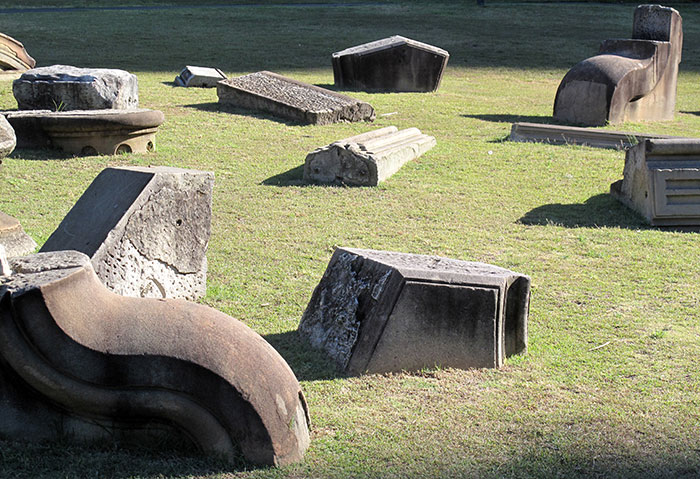
Three days later, I had a funeral for Val. Chang and Droog helped me dig a hole for Val’s ashes in the sandy soil of a bluff above Four Mile Beach where she and I had camped. One of Val’s friends was studying to be a rabbi, and she said some traditional words. I filled the hole and set a little pyramid-shaped rock on top. And then the mourners came to my cottage for a reception. My landlords, Dick and Diane Simly, stayed away, even though I’d invited them.
I served bread and lentil soup, the same as the meal I’d had with Val the night she’d gotten pregnant. And Val’s friends brought some other stuff, cold cuts and roast chicken. Funeral meats. I absolutely couldn’t believe this was happening.
We sat in my back yard, drinking and smoking a little pot, with the guests chatting, and me not saying much. Whenever I tried to talk, my voice broke. To try and keep it together, I kept focusing on tiny visual details like a pebble or a twig, imagining that God and maybe Val were hiding inside.
And then Skeeves, of all people, showed up. With the barest of nods, he walked past me, got himself a beer in my kitchen, and started nosing around on the side porch where I kept my defunct scanning-tunneling microscope. I could dimly see him through the screen, touching things, picking things up. Skeeves rarely held still.
A minute later he was back outside, with his beer in one hand and his other hand in the pocket of his baggy shorts.
“What are you doing here?” I asked him in a low voice as he came near. “You didn’t know Val.”
“But I’m involved,” said Skeeves. “I told Ira to get you that sharp tip. Chang told me about the sad outcome.” He turned his head like a bird, fixing me with one of his oddly flat eyes. “Did you get a chance to see the thing that was growing inside her?”
“What the fuck kind of question is that?” I yelled. I didn’t want to face the thought that my half-assed experiments might have caused Val’s death. I started up out of my chair, meaning to throttle Skeeves into silence.
“Jim!” One of Val’s woman friends caught hold of my arm.
“Touchy guy,” said Skeeves, and ambled back out to the street.
The guilt train was running in my head, and I couldn’t make it stop. The doctors said the growth in Val was cancer—but I’d seen that glowing dot on the night the lightning had struck. My overamped STM machine had made some kind of hole in the fabric of reality—and an evil parasite had drifted through. “It’s all your fault.” Oh, Val. I’d ruined everything.
That evening I noticed the charred little sample sled was gone from my desk. Poor Val’s zapped DNA. For all these months I’d left it on the corner where I’d put it right after the lightning bolt. Evidently Skeeves had stolen it at the reception, sinister creep that he was.
The next day I made an attempt to find Skeeves and ask him about that sample-sled. But nobody around town seemed to know where he was. And Ira had disappeared as well. For whatever reason, they were lying low. Ira had always had a crush on Skeeves—perhaps the two men were together. Never mind, never mind, I needed to let go.
Crying while I worked, I dismantled the scanning-tunneling microscope. I smashed the parts with a hammer and put them all in the trash.
The wheel of the seasons rolled on. I missed Val’s voice all the time, and the way she’d smile at me with her eyes and her mouth. It was terrible to sleep in an empty bed. And always I had the guilt and remorse, right at my side, every hour of the day. Whether or not it made sense, I was sure that I’d killed Val with my stupid scanning-tunneling microscope.
I could have moved away and looked for a new life. But I couldn’t get it together to do anything that drastic. I had a feeling that—without Val—everywhere I went would feel just as blank and dull.
In the summer, the Post Office put me on furlough, which was a sanitized way of saying they were busting me down to a three-day work-week. I didn’t care. If I pinched my pennies, I could still buy pot and pay the rent.
As it turned out, it was good for me to be working less. I finally turned the corner on my grief and self-loathing. I got back into hiking along the bluffs, taking Droog along. I started reading again, and going out to clubs.
The dog had been sleeping on my bed with me ever since Val died, but now, as a real sign of change, I sent Droog back to his cushion in the kitchen. I was ready to stop being a depressed loner.
Little did I know that before long I’d get a chance to go to the afterworld and look for Val.
About the Author
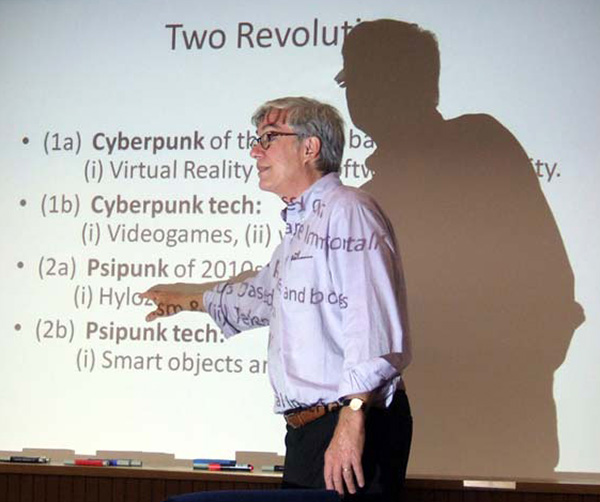
Rudy Rucker is a writer and a mathematician who worked for twenty years as a Silicon Valley computer science professor. He is regarded as contemporary master of science-fiction, and received two Philip K. Dick awards for his cyberpunk novels Software and Wetware. These early novels will be reissued with Freeware and Realware in a single volume as the Ware Tetralogy in April, 2010 by Prime Books.
"Val and Me" is excerpted from the first three chapters of Rucker's forthcoming novel Jim and the Flims.
Please mention the author or this piece's name in your comment.